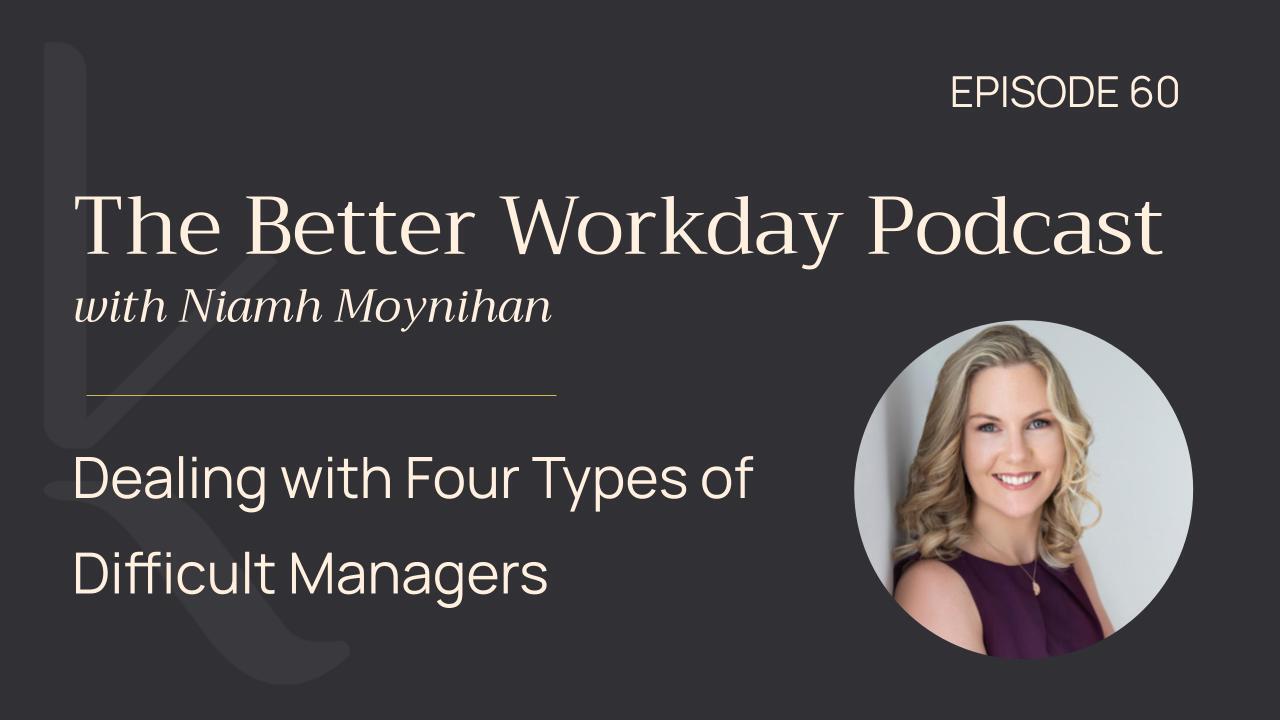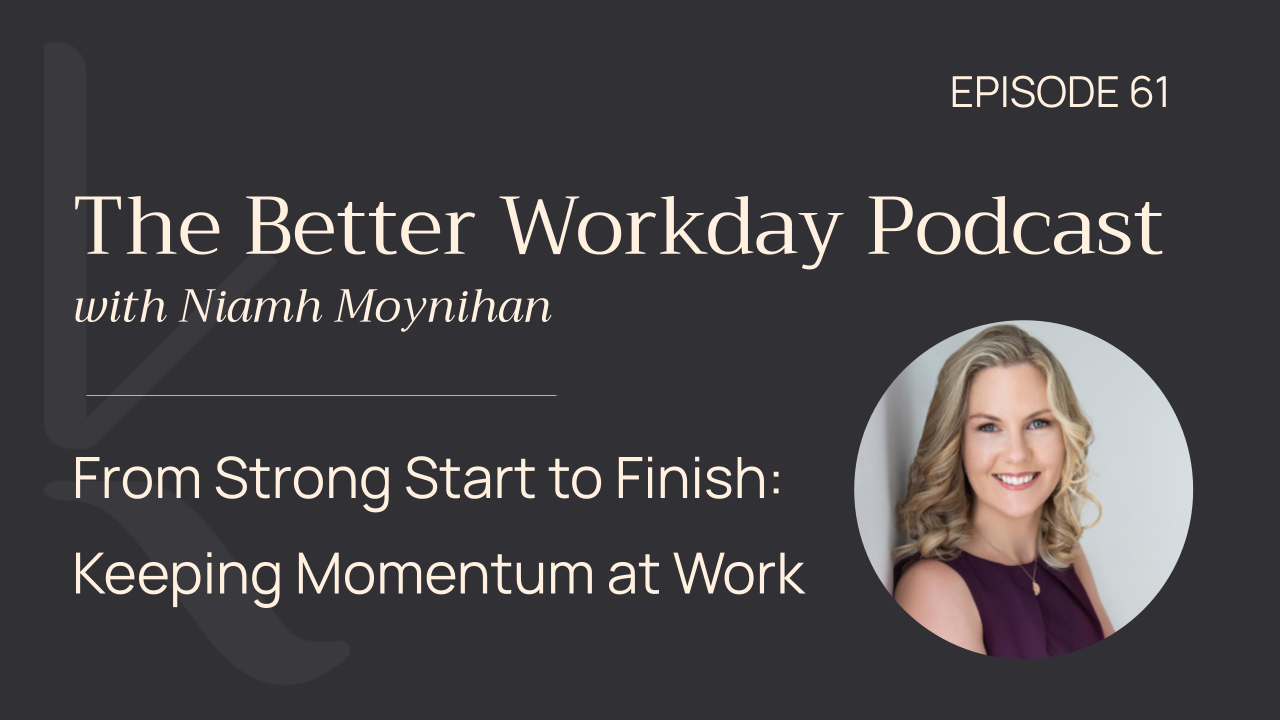Episode 47 | The 5-Star To-Do List
Episode Introduction
In this episode, Niamh revisits a tool from her Better Workday toolkit: the 5-Star To-Do List. She explains how this simple method can help you offload your mental clutter, prioritise your most important tasks, and make meaningful progress, especially when you feel overwhelmed.
Episode Summary
How to Build Your 5-Star To-Do List
Niamh explains that the first step to creating your 5-Star To-Do List is a mental offload. On a blank piece of paper, write down every single task you think you have to do. This includes items from your regular to-do list, calendar, emails, and any mental tasks that haven't been written down yet. This process helps to clear your mind and provides a complete picture of your workload. Niamh notes that a common mistake is to forget to include tasks that are already in progress, which also take up time and mental energy.
Prioritising with Stars
The next step is to select a maximum of five items from your master list that you can realistically tackle today or tomorrow. You can put a star next to them. The number five is a manageable amount that allows you to address tasks from different areas while still feeling in control. If you're still struggling with overwhelm, Niamh suggests reducing the time frame to just one afternoon and limiting your starred items to three. The goal is to reduce the "noise" and focus your attention. Once you have your starred list, choose just one item to work on and take a small, immediate action to get started. This helps to move you from procrast-planning—spending all your time organising rather than doing the work—to making real progress.
-
Write down everything, including things you are already working on, to get a clear picture of your workload.
-
Select up to five tasks that you can work on over the next one to two days and put a star next to them.
-
Reduce the number of starred items to three and the time frame to one afternoon if you still feel overwhelmed.
-
Immediately take a small action on just one of the starred items to get momentum and avoid "procrast-planning".
5 Key Takeaways from the Episode
- Get It All Out: Start by writing down every task on your mind, regardless of its priority. This helps to offload mental clutter and gives you a complete overview of your workload.
- Limit Your Focus: Choose a maximum of five items from your long list that you can realistically work on today and tomorrow. This prevents you from feeling like you have to do everything at once.
- Take Immediate Action: Pick just one of your starred tasks and begin with a small, manageable action. This helps you break through feelings of overwhelm and stops you from getting caught in a cycle of "procrast-planning".
- Keep It Simple: Once you have your five starred items, create a smaller list—a Post-it note, for example—and focus only on those items until they're complete.
- Re-evaluate and Declutter: After making progress, re-examine your main to-do list and feel confident about deciding what isn't needed right now, or at all.
About The Host and Podcast
Welcome to The Better Workday Podcast with your host, Niamh Moynihan. Niamh is the founder of Better Workday. She will challenge you to think differently about how you manage your time, energy, attention and relationships at work to be successful while supporting your well-being.
In each episode Niamh shares new insights and practical ideas to help you create a better workday.
Share This Episode
If you found this episode helpful, please share it with a friend or colleague who might also benefit from these tips. If you would like to support the podcast, please subscribe and leave a rating or review.
The Better Workday Podcast on Spotify
The Better Workday Podcast on Apple Podcast
Episode 47 Full Transcript
Welcome to the Better Workday podcast, with your host, Niamh Moynihan. In each episode, Niamh shares new insights and practical ideas to help you create a better workday. Hello, hello, and welcome back to the Better Workday podcast. How are you doing?
Today, I'm going to talk about an oldie but a goodie from my Better Workday toolkit, and that is the five-star to-do list. Now, when I looked back, I first wrote a blog about this topic in 2018.
And back then, I was still working full-time in my corporate role, there was no children on the scene, and it was a very different work environment for me, and a very different work-life balance set up overall.
But honestly, the years have passed, but the tool itself, it's still as good, and I thought it would be a really nice one to share with you today.
If you're feeling any way overwhelmed by your to-do list, this is a really nice way for you to take back control and to make some progress.
So let's get into it. The five-star to-do list is nothing more than a to-do list, okay? okay, it's a little bit more than just a to-do list, but it starts by you getting out a blank
Well, piece of paper and writing down everything that you believe you have to do. And I'm saying "believe you have to do" because there might be some things there that, you know, might not need to be done after all. But for now, put it all down on a page.
And so this is a really nice way just to mentally offload. So include everything in your traditional to-do list, wherever you keep that, and anything that's on your calendar, anything that's in your email.
Include those things on your mental to-do list that you haven't yet put down anywhere. Get it all out.
And there have been times where, honestly, this took up two to three A4 pages for me. So if it's long for you, trust me, you're not on your own. And as I said, when we get everything out on paper, it just allows you to clear your head a little bit, and even that alone is good.
And now we take it one step further, and this is where the five stars come in. And basically what you're going to do is you're going to pick up to five items that you feel you can tackle today or tomorrow and put a star next to them.
And the reason it's five, quite honestly, is because back in 2018 there was so much that I had to do on any given day that I couldn't just pick one.
You know, traditional priority management of pick the most important thing wasn't working for me, because there was more than one thing that I did realistically have to get done. And yet, if I left it unmanaged, it felt like I had to do everything all at once, and that's not good either.
So I felt that five was a reasonable amount of work that maybe I could prioritize over the next one to two working days. You know, it's enough to make sure that you're covering requests from different stakeholders, and maybe a mix of things that are open and in progress. Oh, and while I'm saying that, actually, one of the biggest mistakes people make when they're writing to-do lists is they write all the things they have to do, and they don't take into consideration the stuff that they're already working on, okay? So the stuff that's already in progress.
But of course, until it's closed, we know that all of these things are going to take up time and mental capacity in your working day. So everything, everything goes on the list.
So coming back to it, you put five stars next to five different items, really, that you can work on. And if you struggle with five, you know, you can go up or down three or seven.
If it's more than that, I would challenge you to shorten the timeframe. So instead of saying, "What can I do in the next two days?" just ask, "Out of all this, what can I do this afternoon?" and limit that to three things.
And so what we're trying to do here is to reduce the amount of noise, reduce the amount of things that are vying for our attention. And then number three for me is where you pick just one of those things, any one of the five, and you decide which one you're going to work on right now, and what small action you can take.
And I love this because, you know, when you're feeling overwhelmed, I don't know about you, but I can just get caught spinning my wheels. You know, I'm picking things up and putting things down.
I'm not really doing much of anything, and it's not helping me, and it's not helping anyone else. So if I can just choose one thing and make a little bit of progress, that helps me to slow down almost, to- to reset, to recalibrate, and to focus on the work that needs to be done once more.
And again, by the time you're finished this, it means that not only have you reorganized yourself, but you've also taken action.
Because another trap a lot of people can fall into is something which is called procrast planning, and especially when things are busy or there's a lot of decisions to be made, I've been guilty of this, I'm sure some of you listening have been guilty of this, that we can spend so much time organizing and reorganizing and prioritizing and reprioritizing and planning, and doing all of the things, doing everything except the work, because honestly, you're not sure where to start.
And so this process really helps you move from that. Once you have that done, so you have written your big list, you have put stars next to five items, and you've taken action on one of them, at that point, I want you to copy the list of five items to a smaller list. I usually use
Post-it note so that the list can't get too long. And just focus on that until they're finished or until they're progressed to a stage that you're happy with.
And then go back to the rest of the list and ask yourself, "Is everything here really needed in the next three to five working days?"
And again, I want you to now start thinking about whether or not you can draw a line through any of them saying they're not needed at all maybe, or they're not needed until next week or the week after.
And again, doing this after you've made some progress means that you're doing it from a place of more confidence and you're in more control of your actions, now you're in more control of your time, and so you may be more confident in the decisions you're making around the rest of the things on that list. So that's it for this week. Sometimes it really is that simple. It's as simple as writing a list, putting a few stars next to it, and getting to work. I think often we're very guilty of over-complicating the work process.
As I always say, life is complicated, so keep work simple. If you found this idea helpful, please, please share it with friends and colleagues. And until next week, stay well and have a better workday. Thank you for tuning in. We hope you enjoyed this episode.
The Better Workday podcast is about helping you have a better workday, so we'd love to hear your thoughts and questions. You can find our social media details, as well as any references from this episode, in the show notes.


